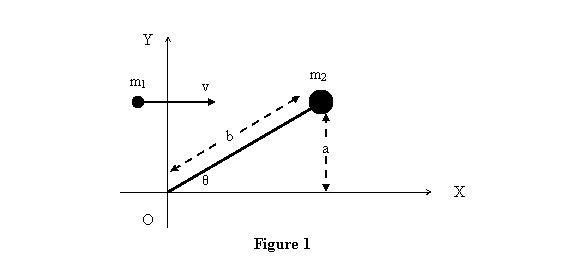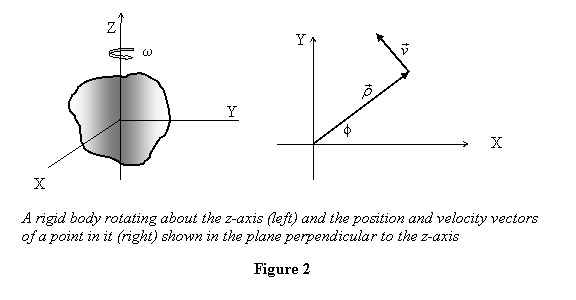We saw in the previous lecture on rigid bodies that a
rigid body in general requires six parameters to describe
its motion, and the dynamic of a rigid body is determined
through its angular momentum  that
satisfies the equation
that
satisfies the equation  ,
where
,
where  is
the applied torque on the body. Further,
is
the applied torque on the body. Further,  means
that
means
that  is
a constant.
is
a constant.
In this lecture I start with an example of the conservation
of angular momentum involving two particles. I again
show that a direct application of Newton 's laws and
a solution through the conservation of angular momentum
give the same answer.
Example 1: There is a rigid massless
rod of length b held at point O carrying
a mass m2 at
its other end. Let the y-coordinate of m2 be a. Another
mass m1 comes parallel to the x-axis and
hits m2 and
the two masses get stuck together (see figure 1). Question
is at what speed will the rod rotate?

Let us apply the conservation of angular momentum to the
system of two masses about point O. This is
because the only external force acts at O so
the torque about O is zero and therefore the
angular momentum about O is conserved. Since
the particles are moving in the xy plane, their
angular momentum is going to be in the z direction.
So we write the unit vector explicitly and work in terms
of numbers (both positive and negative) only. Assume
that the angular velocity of the rod after the mass m1 gets
stuck with it is ω. To apply angular momentum
conservation we calculate the angular momentum
of the system before and after collision and
equate them.
Initial angular momentum about O =
m1 va
Final angular momentum = (m1 +
m2 )b2 ω
Equating the two gives

Let us now see if the conventional force analysis also
gives the same answer. The incoming mass m1 comes
in with momentum m1v. Now
after m2 is
hit, it cannot have any movement parallel to the rod
because the rod is rigid, i.e. the rod is capable of
generating enough tension (impulse) in it to make the
component of momentum parallel to the rod zero. On the
other hand, there is no force perpendicular to the rod
so the momentum component
p  in that
direction remains unchanged after the hit. Now
in that
direction remains unchanged after the hit. Now

After the masses get stuck together, p  remains
the same. Thus the new speed v' acquired
by the masses will be such that
remains
the same. Thus the new speed v' acquired
by the masses will be such that

This gives

which is the same as obtained by angular momentum conservation.
Thus again showing the equivalence of the two methods.
With all this preparation, let us now start with the simplest
motion of a rigid body that is the rotation of a rigid
body about an axis fixed in space. So the axis is neither
translating nor rotating. Without any loss of generality,
let us call this axis the z-axis. In this case the body
has only one degree of freedom and the only variable
that we need to describe the motion of the body is the
angle of rotation about the axis. Further, the only relevant
component of angular momentum in this case is the component
along the z-axis. Note that there may be other components
of angular momentum but their change is accounted for
by torques applied on the axis to keep it fixed in space.
Calculation of such torques will be discussed in later
lectures. Suffices here is to say that these torques
arise out of the constraint forces that enforce the constraint
of the axis being fixed in space.
Shown in figure 2 is a rigid body rotating about the
z-axis with an angular speed ω. Also shown
there is the position and velocity vector of one
of its constituent particles of mass mi in a plane perpendicular
to the rotation axis. We wish to calculate the z component
of the angular momentum.

The z component will be given as

For a particle at distance ρi from the z-axis
and its radius vector making an angle Φi from
the x-axis

so that

Calling  the
moment of inertial about the rotation axis, we can write
the
moment of inertial about the rotation axis, we can write

Depending on the direction of ω, angular momentum about
an axis could have negative or positive values because
it is a vector quantity. The convention we take is the
right-hand convention; Let the thumb of one's right hand
point in the positive z direction; if the rotation of
the body is in the same (opposite) direction as the fingers,
ω is positive (negative).
Having defined the moment of inertia about an axis, we
make a few comments on it. First thing we notice about
it is that it depends on the perpendicular distance of
point masses from the axis of rotation. So no matter
where we take the origin of the coordinate system, the
moment of inertia of a rigid body about an axis is always
going to be the same. Secondly, for continuously distribute
mass moment of inertia is calculated as the integral

where ρ is the perpendicular distance of a small
mass element dm taken in the body (see figure
3).

Finally, for planar objects the moment of inertia is the
same as the second moment of an area except that the
area is replaced by the mass.
We now calculate moment of inertia of some objects.